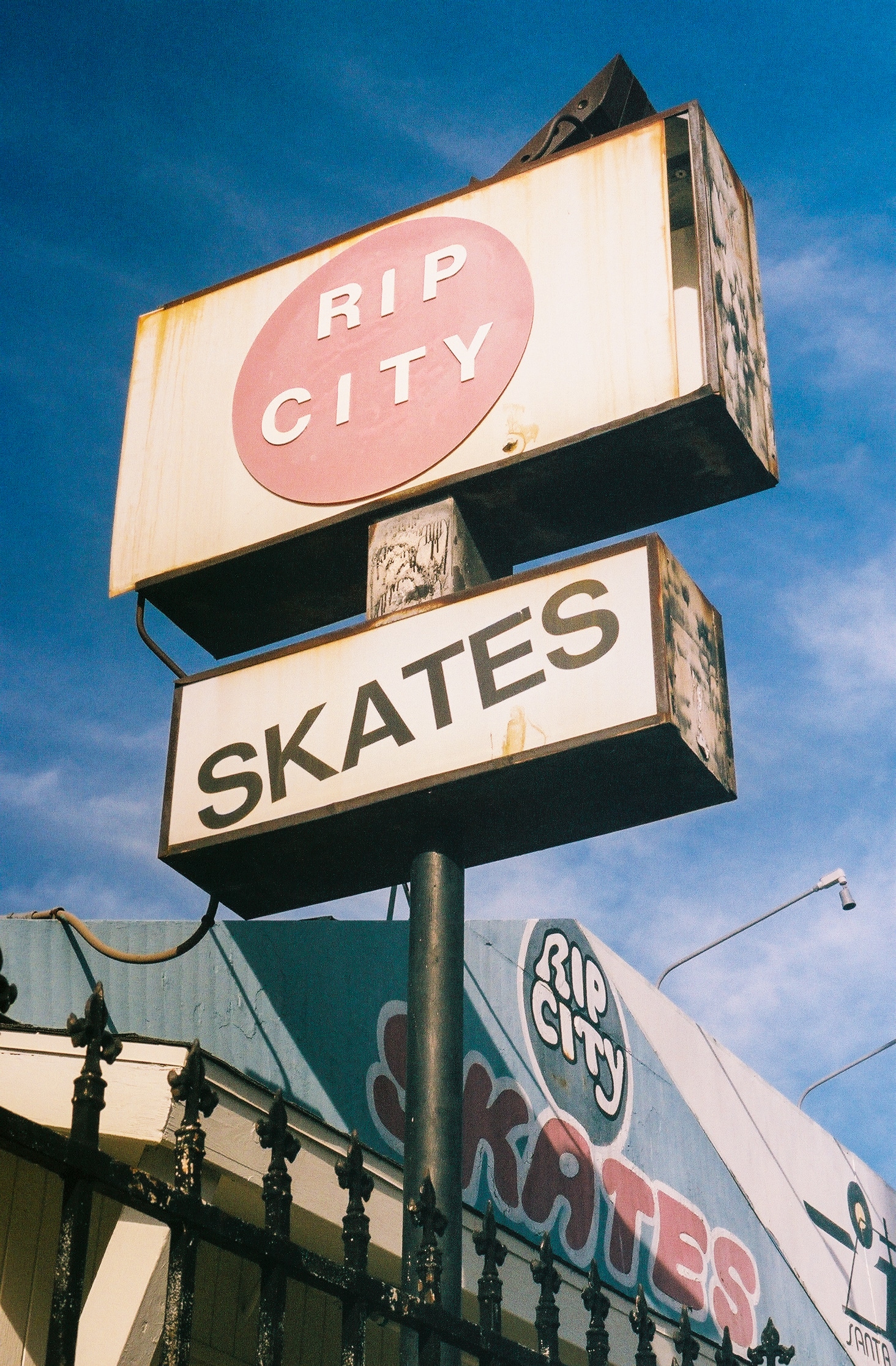Update (8/15/2020): Chris Candy with Rip City Skates has confirmed with L.A. Taco that L.A.'s oldest skate shop will remain at 2709 Santa Monica Blvd for the foreseeable future. The developer who purchased the property last year is reportedly no longer seeking a demolition permit and is planning on putting the property back on the market. For now, Rip City lives on.
[dropcap size=big]R[/dropcap]ip City Skates, L.A.’s longest continuously operated skate shop is likely moving soon. The Santa Monica building that they’ve operated out of for more than 40 years is set to be demolished. The iconic skateboard shop has been around almost as long as skating has.
Earlier this month, Chris Candy, a former Rip City Skates employee began collecting signatures to make 2709 Santa Monica Blvd a historical landmark and potentially save Rip City. The Change.org petition has garnered over 12,000 signatures.
Jim McDowell, one of Rip City’s co-owners, and other staff tell L.A. Taco they appreciate the support but stress that they do not want to see the building become a landmark. They fear that it will only lead to a substantial rent increase and problems with their landlord. “We’ve had a really nice run here, 40 plus years. It’s good, you can’t look back, you look forward,” McDowell says. They’re planning on eventually moving to another location, hopefully somewhere else in Santa Monica.
At the end of the day, Candy says he’s looking out for McDowell and his business partner Bill’s best interest, “At this point, I care more about getting them settled,” Candy tells L.A. Taco. According to Candy, obtaining landmark status is complicated and wouldn’t necessarily protect Rip City. “It would be a different story if they owned the land,” he says.
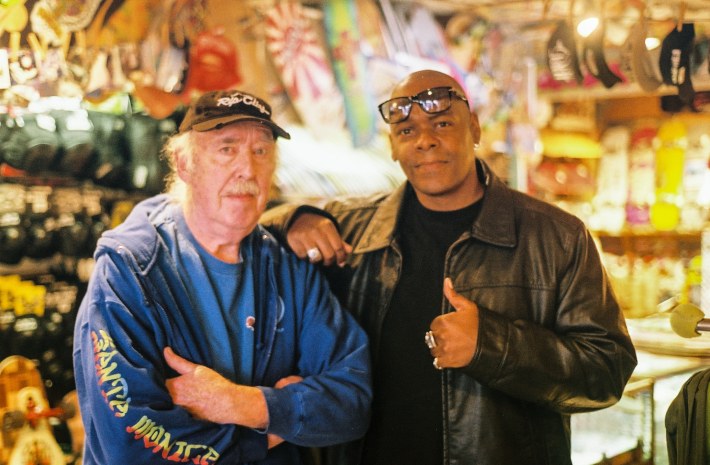
McDowell estimates that Rip City will be open at its current location for at least another year. He notes that the property next door, an old mechanic shop, has been pegged for demolition for over 4 years. Regardless of what happens, McDowell has been humbled by all of the support from the community. He’s received numerous calls in addition to customers who ask about the status of his business when they come in. Santa Monica Brew Works has said they’re going to name a beer after Rip City and Dogtown Skateboards has something in the works to honor the iconic skateboard store.
The demolition is still subject to approval by the city of Santa Monica and structures older than 40 years old are automatically forwarded to the Landmarks Commission for review, so there’s still a slim chance that the building could be saved, but McDowell and his partner aren’t praying for any miracles. “It’s in the hands of the gods now,” McDowell tells L.A. Taco.
Rip City Skates Is Like an Unofficial Skateboard Museum
Patrick Abreu, a Santa Monica lifer and current employee, has been going to Rip City since the first week they opened on April fools day in 1978, “I’ve been skating my whole life,” Abreu tells L.A. Taco during a cigarette break at work. He says he’s going to miss the building the most, “The decor inside, it’s not gonna look the same.”
Rip City Skates is like an unofficial skateboard museum. The walls are canvassed with skate memorabilia-like wallpaper. There are countless photos, skateboard ads, stickers, trophies, and of course skateboard decks strewn across the store. Decks shaped like knives and guns, odd-shaped cruisers, micro boards, throwbacks to the early days of skating and plenty of your traditional modern street skateboards, some of them worth thousands of dollars and as old as the shop.
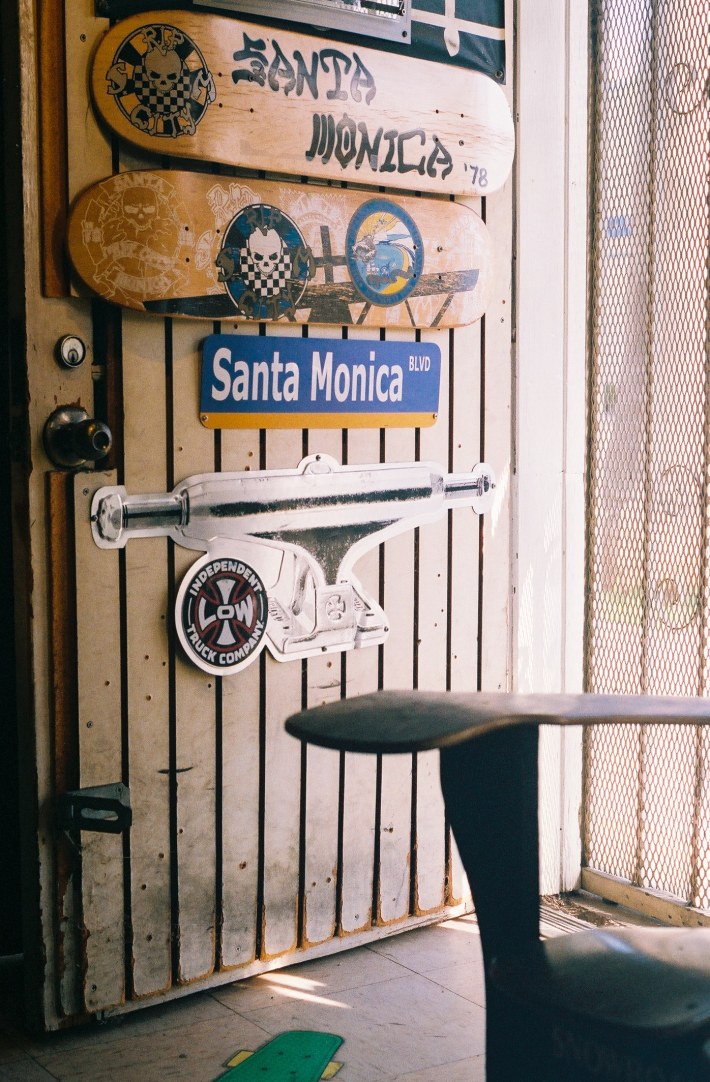
“The store has always been basically the same,” legendary skateboard pioneer and artist, Steve Olson, tells L.A. Taco, “Just different gear from the different generations it has survived.” Olson first stepped into Rip City the year it opened when he was 16. Olson lived in Long Beach with his family in 1978 when he wasn’t on the road. “I would see weirdos rolling out cruising by the skate shop...after a relaxing visit,” Olson recalls a vivid memory of a massage parlor being next door to Rip City via Instagram.
“The party doesn’t start until Steve Olson arrives,” McDowell, who calls Olson a great-guy, chuckles when we bring the story up during our interview with him. “I think it was a palm reader actually, one step below a massage parlor,” McDowell confirms.
Williams explains what makes Rip City different than other shops around the world and central to the skateboarding industry. “Guys weren’t always sponsored,” he adds that McDowell would help riders out when they didn’t have boards. “He fueled skateboarding, he kept it going,” Williams says.
“We opened this store in 1978 and said ‘hey, this looks like a good idea, let’s give it a couple of years,’” McDowell tells L.A. Taco during a brief break in between customers, on a recent Wednesday afternoon. The store is never empty. There’s a constant stream of old and new customers. One family even went out of their way to stop by before heading back to France because they heard Rip City was moving.
McDowell says that sales spike during the holidays but reiterates that they’re always busy. He loves what he does for a living, “As long as you enjoy what you’re doing you’re never working a day in your life,” he says.
Rip City Skates Through the Skating Ages
Rip City opened its doors as skateboarding was beginning to gain popularity and it has survived all the various incarnations of skating since. McDowell, who was never a skater happened to get into the business at just the right time. Santa Monica and Venice would become the epicenter of skateboard culture during the 70s and 80s.
“This is Dogtown,” third-generation Dogtown skater and fine art photographer, Pep Williams, refers to the skate term used to identify Santa Monica during an interview in his jet-black Dodge Challenger parked in the Carl's Jr. lot next to Rip City.

In the mid-70s, skateboarding evolved from surfing–when there were no waves to ride, surfers road the concrete waves inland on skateboards in the form of abandoned backyard pools and wooden ramps.
“At the time, in the 70s and 80s [Dogtown] was the mecca, so every skater came here,” Williams explains what makes Rip City different than other shops around the world and central to the skateboarding industry. “Guys weren’t always sponsored,” he adds that McDowell would help riders out when they didn’t have boards. “He fueled skateboarding, he kept it going,” Williams says.
Pep Williams, another longtime regular, came up in Florence and Watts. He has been coming to Rip City Skates since 1986, the year he needed his first wheels. He began skating in 1975 and first encountered Venice when he was 13 years old; he’s 48 now. “I was just catching the bus because I used to make fake bus passes, I got on the bus one day and it ended in Venice. I saw guys like me, riding on boards and I said, ‘This is home.’”
He caught the bus all the way from Watts and got off at Rip City on Santa Monica Boulevard, where he met McDowell. “Since then we’ve been friends,” Williams says.
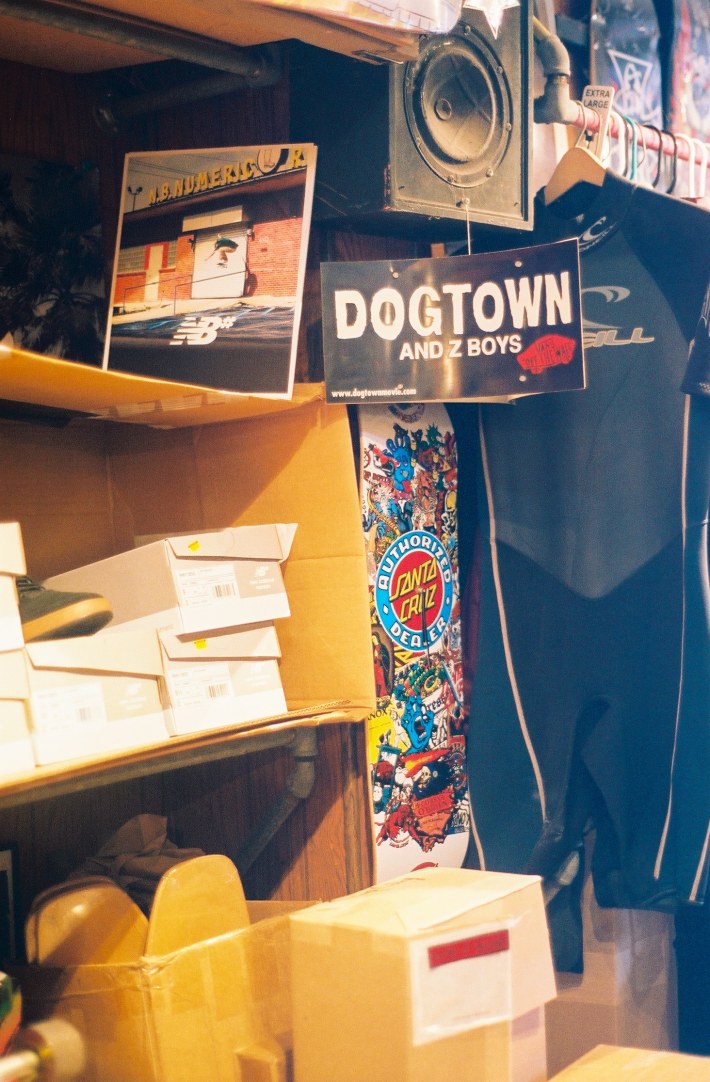
Skateboarding was the catalyst for Williams’s photography career. He got his start as a photog during a fashion show that he modeled in. When the designer’s photographer didn’t show up and Williams found out the gig paid $6,000, he stepped in with no experience. “I said, ‘I’m a photographer.’”
From there, Williams took advantage of the fact that he was traveling the world as a pro skater. He documented the skateboard scene during the 90s and eventually got into shooting fashion and music artists. Today his work hangs in some of the finest museums all over the world and his prints sell for tens of thousands of dollars but he hasn’t lost touch with his roots. He’s happy to stop by Rip City and chop it up with McDowell for a minute, even while he prepares to open a new exhibit at the Autry Museum.
Although though he never got into skating, Jim McDowell runs his shop like a true skateboarder would—just riding through the cracks and pebbles of life.
“You see the types of people that come here, they’re not even skaters, they just know that this is the place to go,” Williams highlights the diversity amongst Rip City’s clientele. On the day that we stopped by, moms drop in with Christmas lists from their kids, and older guys with families regularly cycle through the store. McDowell’s client base doesn’t necessarily fit the mold of the stereotypical skateboarder.
Is There Still a Place for Skate Shops in Los Angeles?
Williams says he believes that there will always be a place for skate shops in L.A., despite the advent of online shopping and the recent wave of gentrification that’s consumed neighborhoods like Venice and Santa Monica. He grew up at a time when the westside was different, “The people down there now wouldn’t even be allowed to go. You couldn’t go on Abbot Kinney Boulevard, we didn’t even go to Oakwood unless we had permission to go. Now when I see people on Abbot Kinney walking their dogs, I say ‘Wow, what a difference time makes.’”
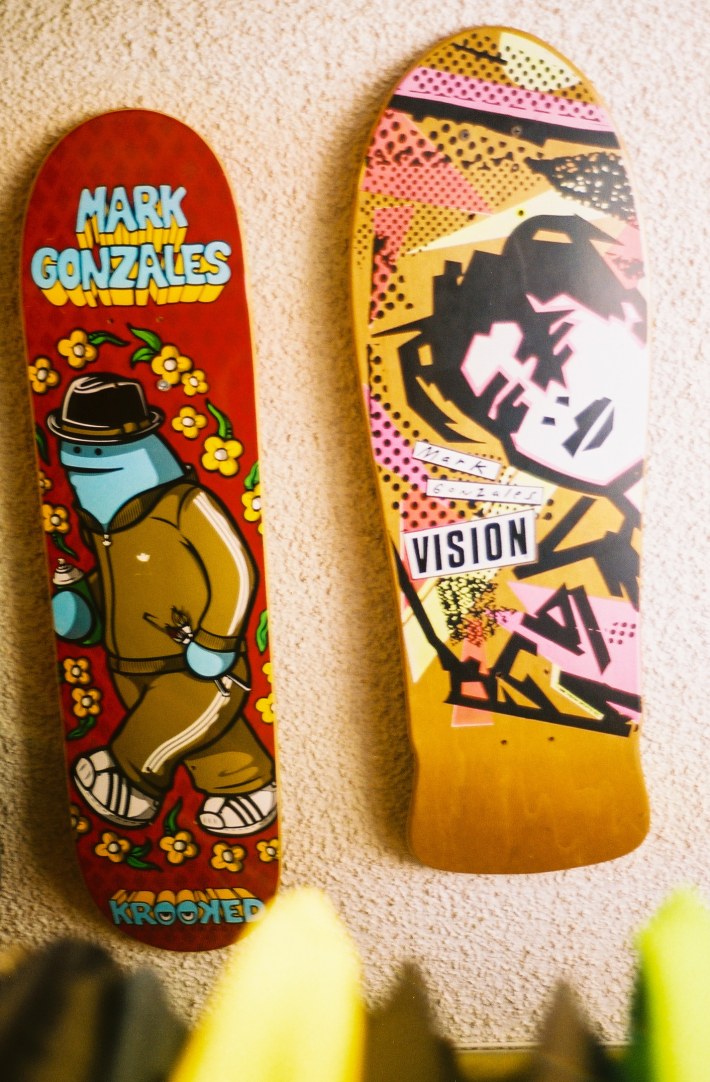
Williams acknowledges that Rip City is more than just a place to buy stuff though, at its core, it’s a place that brings people together, a spot to hangout. “A lot of shops, they just want you to come in and buy the product and leave. We would just come to hang out. Some of my best times are when it’s just me and Jim and we just talk, it’s not about skating,” Williams says.
The city of Santa Monica might not declare 2709 Santa Monica Boulevard a historical place but to the skate community, Rip City Skates will always be a landmark.
“So many stories you can’t tell, so many celebrities you don’t want to know about,” McDowell reflects on Rip City’s rich history fondly without divulging any secrets.
Skateboarding has always been more of a lifestyle than a sport. That’s why it welcomes so many different kinds of people. And Rip City Skates has always understood that. Although though he never got into skating, Jim McDowell runs his shop like a true skateboarder would—just riding through the cracks and pebbles of life.
The city of Santa Monica might not declare 2709 Santa Monica Boulevard a historical place but to the skate community, Rip City Skates will always be a landmark.
